Global commercial display market is estimated to be valued at US$ 63.49 Bn in 2025 and is expected to reach US$ 97.43 Bn by 2032, exhibiting a compound annual growth rate (CAGR) of 6.3% from 2025 to 2032.
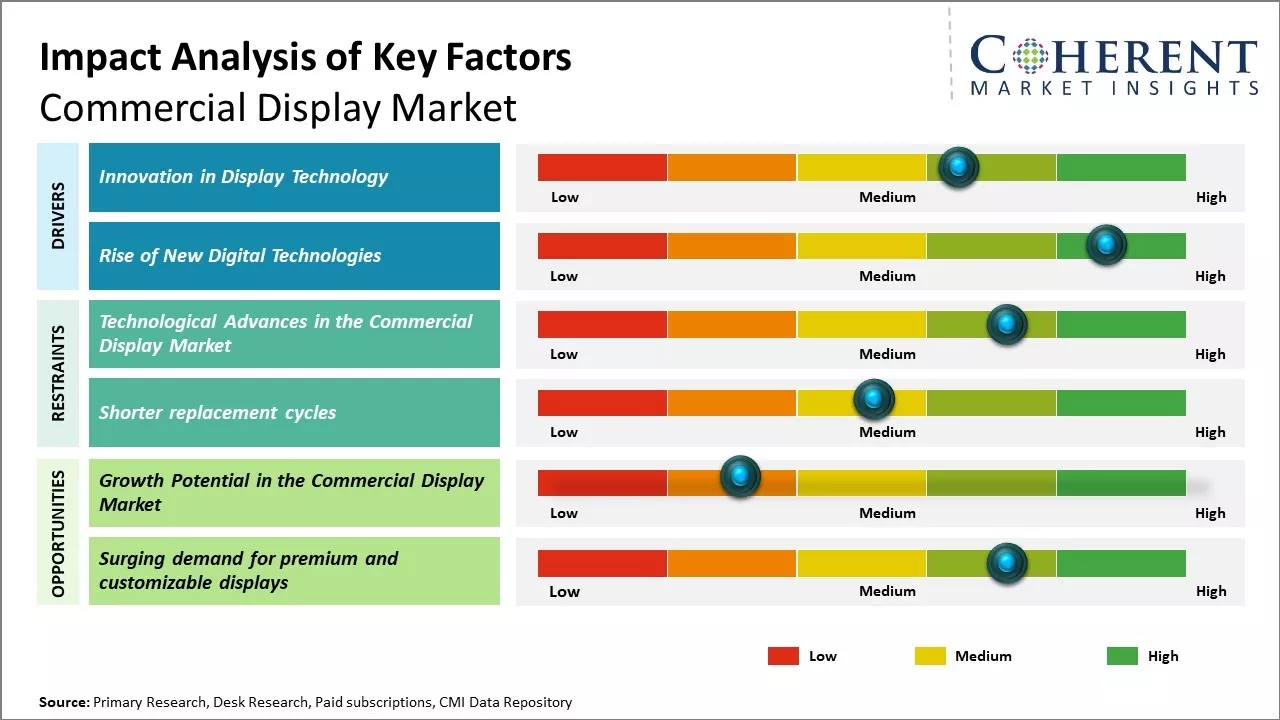
Discover market dynamics shaping the industry: Request sample copy
Global commercial display market is witnessing huge demand for large screen displays with higher resolutions. 4K and 8K displays are gaining adoption in various commercial settings like retail stores, sports arenas, and corporate offices for better visual experiences. Furthermore, New technologies like quantum dots, micro-LED, and mini-LED displays are on the rise. These advancements offer brighter screens, better contrast, and use less energy. Advancements in processing power, AI and 5G network infrastructure is also supporting interactive and multi-user commercial displays. The demand for flexible displays and rollable screens are expected to increase with innovative form factors and mount options becoming available for commercial customers.
Market Drivers: Innovation in Display Technology
The commercial display market has been witnessing strong growth over the past few years due to rapid innovation in display technology. As technology advances, the possibilities for commercial displays are endless. High-resolution and large-scale displays are becoming more affordable, and this boosts more organizations to upgrade their old displays.
4K and higher resolution displays provide incredibly sharp and clear images that make lessons, presentations, and other visual content much more engaging and easier to view from a distance. Many schools and corporate offices have started implementing these high-def displays in their conference rooms, training centers, and auditoriums. The current trend of moving towards 8K displays offer an immersive viewing experience. Vendors are also developing micro-LED, Mini-LED and OLED technologies which provide superior contrast, viewing angles and response times compared to traditional LCD or LED-lit displays.
Innovation is also happening in the size and form factor of commercial displays. Displays with sizes ranges from 85 inches to over 150 inches are becoming increasingly common. These are ideal for immersive digital signage installations in retail stores, museums, airports, stadiums, and other public places. Large format displays mounted on rolling stands have further increased flexibility. There is also growing demand for interactive flat panel displays, video walls, transparent LED displays and outdoor displays capable of withstanding different weather conditions. All of these new display types allow businesses to upgrade their digital infrastructure and enhance customer engagement.
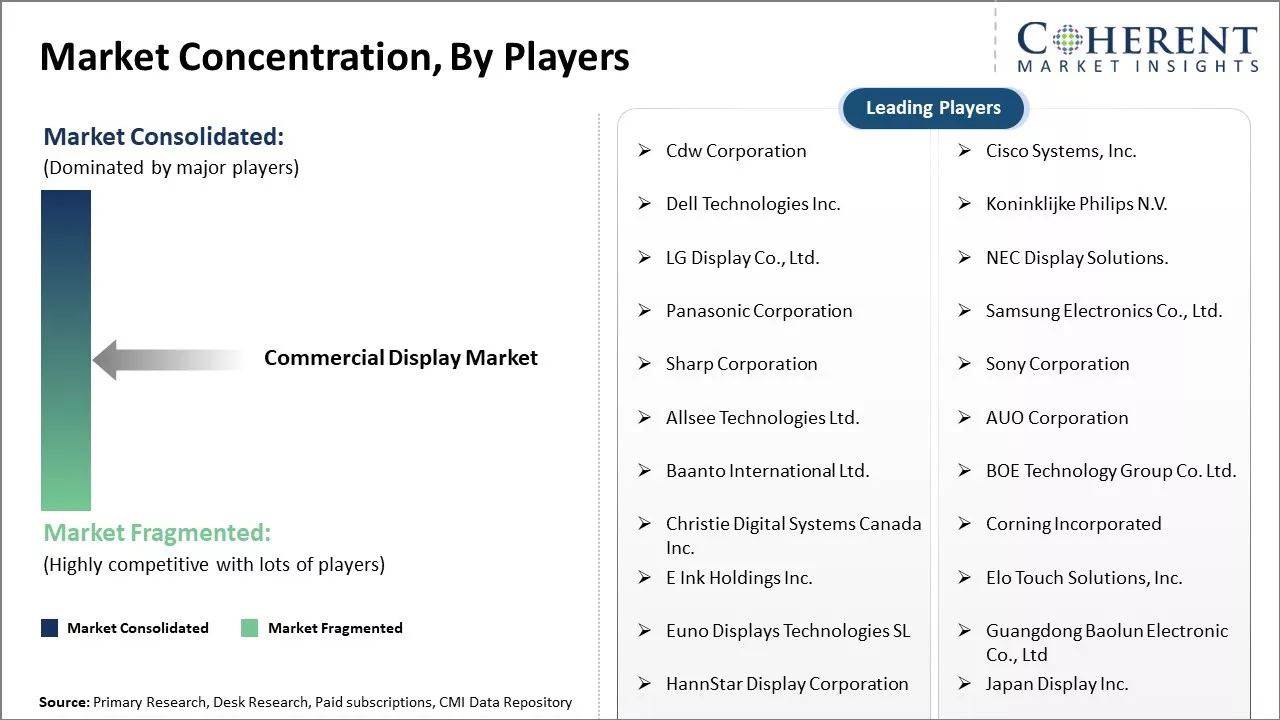
Get actionable strategies to beat competition: Request sample copy
Market Driver: Rise of New Digital TechnologiesCommercial displays play a vital role in experiencing various new digital technologies that are becoming popular, like virtual and augmented reality. As VR and AR applications are deployed more widely in various sectors for training, design, data visualization, gaming and more, there will be greater need for high-fidelity commercial displays. Many educational institutes and corporates are exploring immersive VR classrooms and training rooms where quality commercial displays are necessary to seamlessly run VR simulations without latency or blurriness issues that can cause discomfort.
Display walls and video walls are finding increased application in control rooms across many industries for integrated command and control systems using IoT and analytics technologies. The ability to view live feeds, maps, charts and data from multiple intelligent systems simultaneously boosts demand for advanced commercial display solutions. Industrial and oil & gas companies are implementing digital signage, 360-degree surveillance displays and telemetry monitoring displays powered by AI/ML models.
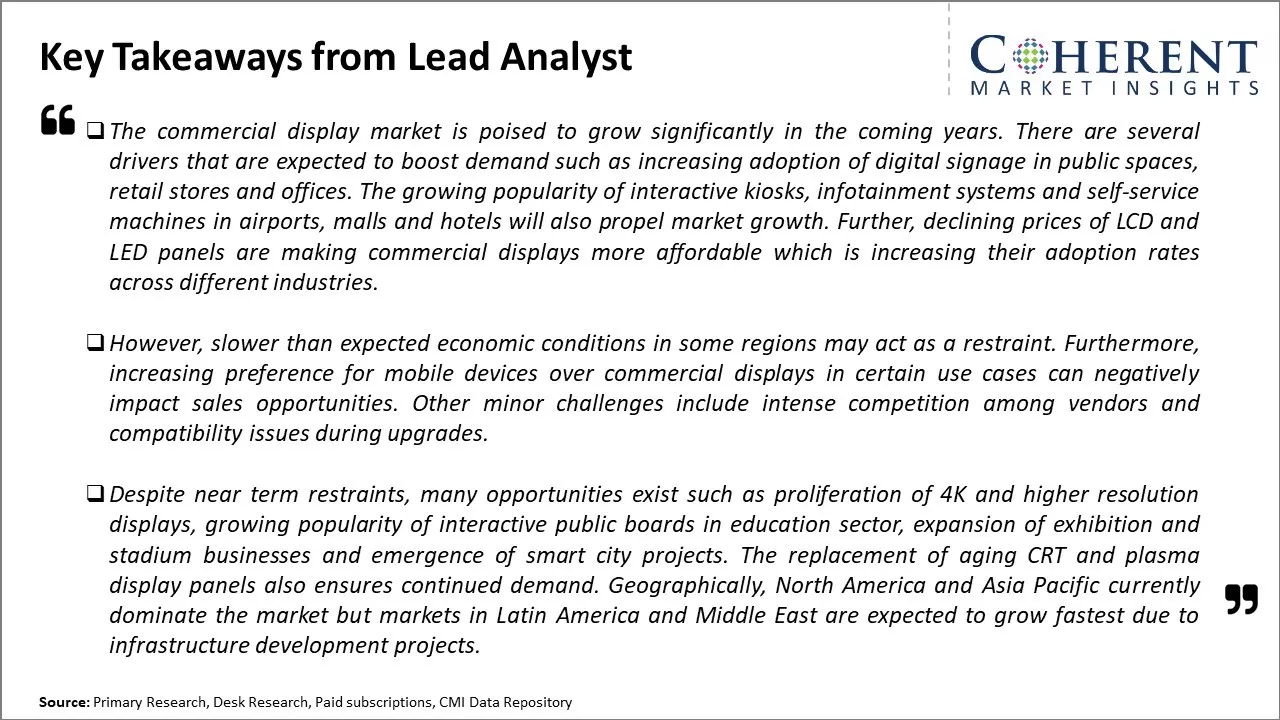
To learn more about this report, Request sample copy
Market Challenges: Technological Advances in the Commercial Display MarketThe commercial display market faces various technological challenges with innovations happening at a fast pace. With newer display technologies emerging such as OLED and micro-LED, there is a constant need to update offerings to stay relevant. This poses supply chain and production challenges for manufacturers to efficiently transition to newer technologies while addressing customer demand.
Market Opportunities: Growth Potential in the Commercial Display Market
The demand for commercial displays is projected to increase due to their usage in various sectors such as retail, hospitality, events and corporate offices. This widespread adoption opens up opportunities for manufacturers and vendors to develop differentiated products catering to diverse industry-specific and application-specific requirements. There is also a chance to address upgrading needs of installed base of displays that are ageing which ensures continued business growth.
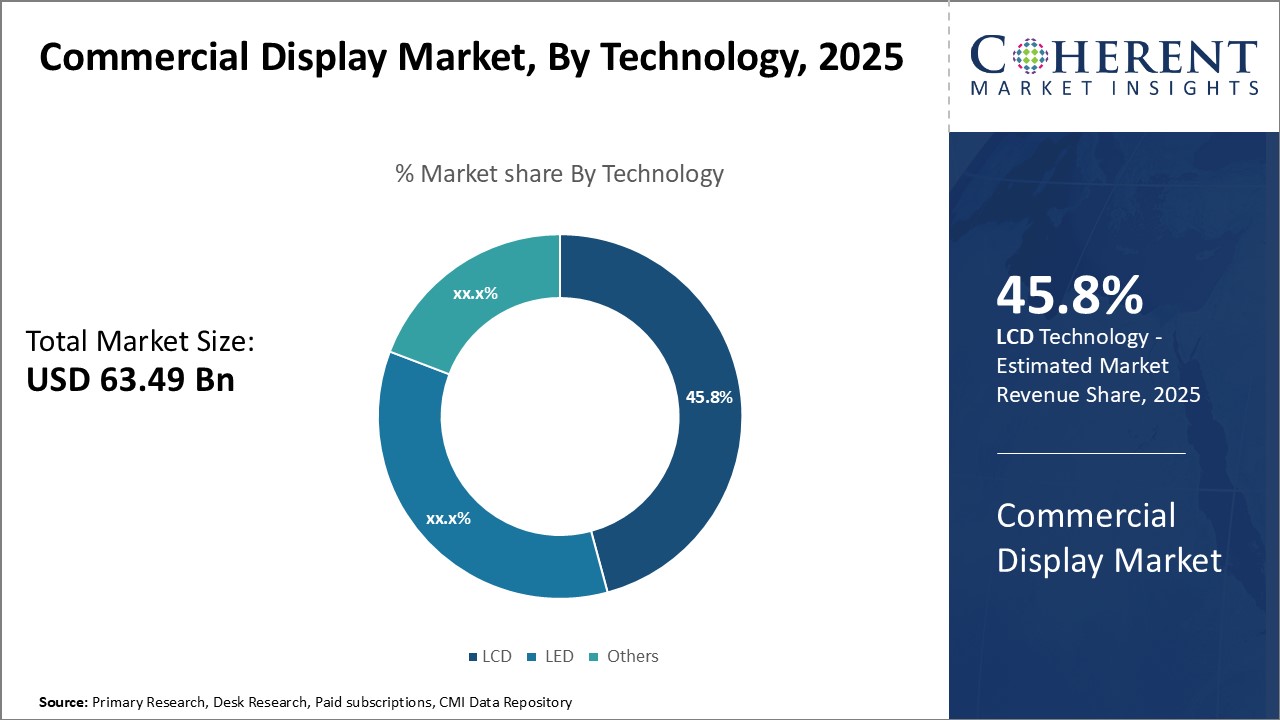
Discover high revenue pocket segments and roadmap to it: Request sample copy
Insights, By Technology- Superior display quality boosts LCD segment growthIn terms of technology, LCD segment is estimated to contribute the highest share of 45.8% in 2025 of the market due to its superior display quality as compared to other technologies. LCD displays offer high resolution, vibrant color reproduction, wide viewing angles and thinner profile as compared to LED and other panel types. The exceptional image clarity and detailed pictures provided by LCD makes it the preferred choice for applications where high quality visuals are crucial like digital signage in retail stores, conference rooms and exhibition halls.
LCD is also able to produce larger screen sizes as compared to other technologies while maintaining reasonable power consumption and cost. This allows it to satisfy the growing demand for bigger display panels across various industries. Its energy efficiency is another important factor as organizations aim to reduce electricity bills through eco-friendly displays. LCD is highly scalable that provides buyers flexibility to choose screens according to their specific needs.
Another strength of LCD is its ability to deliver consistent performance irrespective of ambient lighting conditions. The illuminated backlight ensures bright, sharp images are produced even in poorly lit environments. This makes LCD ideal for 24/7 usage in places with fluctuating light levels like airports, hotels and outdoor digital boards. LCD panels also have a considerably longer operational lifespan of over 50,000 hours before replacement is needed.
Insights, By Component- Hardware Dominates as Foundation for Commercial Displays
In terms of component, hardware segment is estimated to contribute the highest share of 52.9% in2024 of the market since it forms the core foundation on which commercial displays function. The display panel is the most vital hardware component without which the visual experience cannot be delivered. Other essential hardware pieces include stands, mounts and enclosures required for physical installation and rigidity of large sized screens in various commercial setups.
While software and services play valuable supporting roles, hardware carries out the primary task of image rendering on the screen. Advanced hardware specifications like 4K/8K resolution, wide color gamut, high refresh rate and touchscreen capabilities have become necessary to satisfy the imagery demands of key industries. Cutting edge processor technologies also contribute to seamless connectivity and interactivity features.
The significant upfront investment in acquiring top-notch commercial display hardware is reasonable given their essential role in mission control centers, medical imaging, stock trading floors and more. Failure or downtime of such displays can significantly hamper business operations. Hence, sturdy hardware equipped with the latest technologies remains the fundamental backbone, driving the hardware segment.
Insights, By Display Type- Vast Application Scope Boosts Flat Panel Dominance
In terms of display type, flat panel segment is estimated to contribute the highest share of 49.7% in 2025 of the market owing to its ubiquitous suitability across a wide variety of commercial contexts. Flat panels are preferred over other structure types due to their simple, space-efficient rectangular form factor. This allows for flexible installation on walls, stands, ceilings or even as Video Walls without complex angled structures.
The two-dimensional flat surface neatly fits into any commercial interior space and avoids undesirable protrusions. This makes flat panels an ideal fit for applications requiring continuous streaming of information to large audiences like corporate boardrooms, financial trading floors, transport hubs and educational institutions. Their straightforward mounting and unhindered front viewing experience also increases viewer engagement for media like digital signage in public places.
Flat panels are preferred by multiple industries since these do not restrict placement close to walls or within limited space setups. This has increased their deployment across transportation, healthcare, retail and other domains with spatial constraints. Advancements like bezel-less designs have further amplified their seamless multi-screen arrangement to deliver immersive experiences. Maintenance of flat panels is also straightforward compared to curved or semi-circular structures.
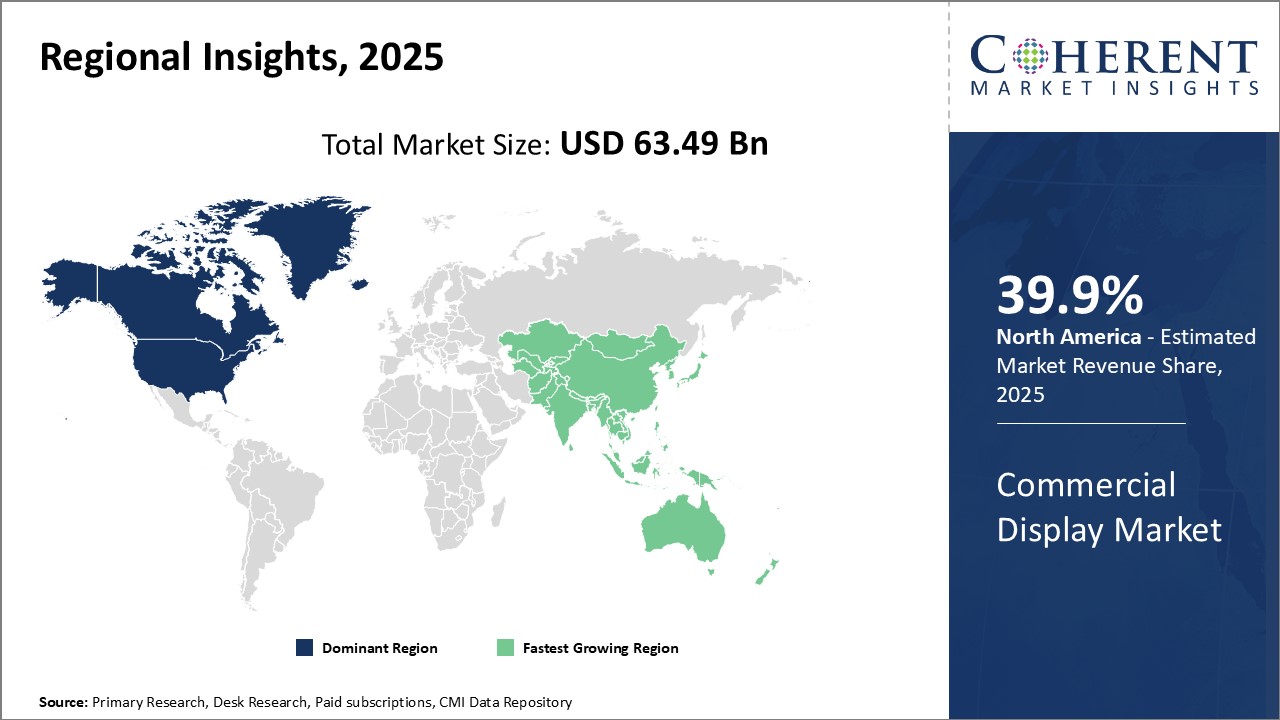
Need a Different Region or Segment? Customize now
North America has established itself as the dominant region in the global commercial display market. With presence of prominent display manufacturers and a large number of commercial organizations adopting digital displays in their operations, the region is estimated to account for over 39.9% in 2025 of the total market share. The U.S is the largest market, driven by high technology adoption across various industries such as retail, hospitality and corporate offices. The advanced IT infrastructure and growing preference for interactive displays for presentations and meetings have tremendously contributed to the regional supremacy. Moreover, leading organizations make sizeable investments in research and development, allowing continuous product innovation, thereby, strengthening their stronghold.
The Asia Pacific region has emerged as the fastest growing commercial display market globally. Rapid urbanization and economic growth and rising disposable income levels in countries such as China and India have propelled the commercial sector development. This has boosted demand for commercial displays across various sectors including, retail stores, airports, train stations, and others. The presence of affordable manufacturing capabilities and availability of low-cost labor have attracted major global display brands to establish production facilities in the region. This has ensured price competitiveness of displays compared to other markets. Furthermore, the expanding consumer electronics industry and the strengthening of local brands have given a boost. China and South Korea, in particular, are leading exporters, enhancing their global market share. The extensive economic reforms and growing focus on public infrastructure projects present augmented growth opportunities going forward.
Commercial Display Market Report Coverage
| Report Coverage | Details | ||
|---|---|---|---|
| Base Year: | 2024 | Market Size in 2025: | USD 63.49 Bn |
| Historical Data for: | 2020 To 2024 | Forecast Period: | 2025 To 2032 |
| Forecast Period 2025 to 2032 CAGR: | 6.3% | 2032 Value Projection: | USD 97.43 Bn |
| Geographies covered: |
|
||
| Segments covered: |
|
||
| Companies covered: |
Cdw Corporation, Cisco Systems, Inc., Dell Technologies Inc., Koninklijke Philips N.V., LG Display Co., Ltd., NEC Display Solutions., Panasonic Corporation, Samsung Electronics Co., Ltd., Sharp Corporation, Sony Corporation, Allsee Technologies Ltd., AUO Corporation, Baanto International Ltd., BOE Technology Group Co. Ltd., Christie Digital Systems Canada Inc., Corning Incorporated, E Ink Holdings Inc., Elo Touch Solutions, Inc., Euno Displays Technologies SL, Guangdong Baolun Electronic Co., Ltd, HannStar Display Corporation, Japan Display Inc., Kent Displays, Inc., Koninklijke Philips N.V., Panasonic Corporation, Planar Systems, Inc., Shenzhen Tiancheng International Technology Co., Ltd., TCL China Star Optoelectronics Technology Co.,Ltd., Tech Global Inc., ViewSonic Corporation |
||
| Growth Drivers: |
|
||
| Restraints & Challenges: |
|
||
Uncover macros and micros vetted on 75+ parameters: Get instant access to report
Share
Share
About Author
As an accomplished Senior Consultant with 7+ years of experience, Pooja Tayade has a proven track record in devising and implementing data and strategy consulting across various industries. She specializes in market research, competitive analysis, primary insights, and market estimation. She excels in strategic advisory, delivering data-driven insights to help clients navigate market complexities, optimize entry strategies, and achieve sustainable growth.
Missing comfort of reading report in your local language? Find your preferred language :
Transform your Strategy with Exclusive Trending Reports :
Frequently Asked Questions
Joining thousands of companies around the world committed to making the Excellent Business Solutions.
View All Our Clients
US Reciprocal Tax Impact Analysis On Commercial Display Market
Stay updated on tariff changes with expert insights and timely information